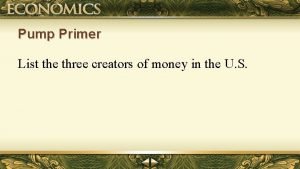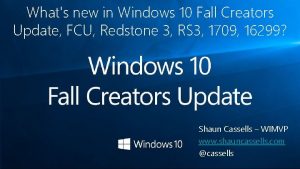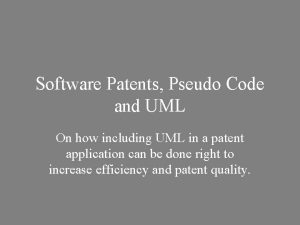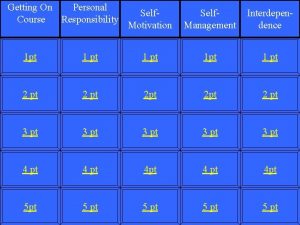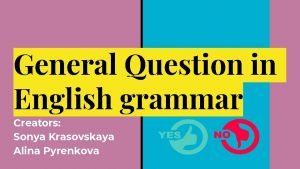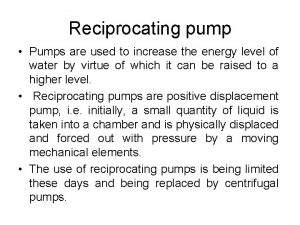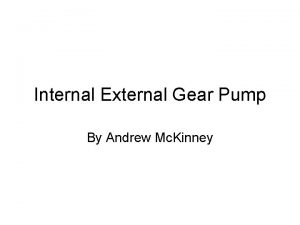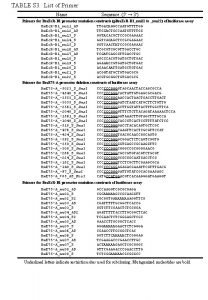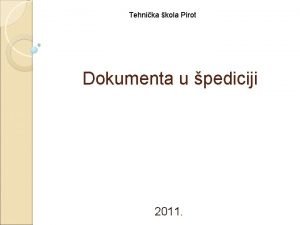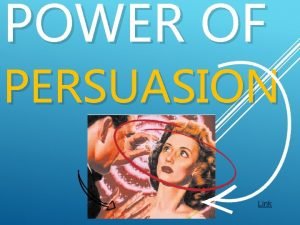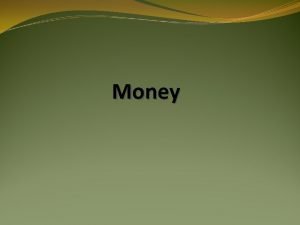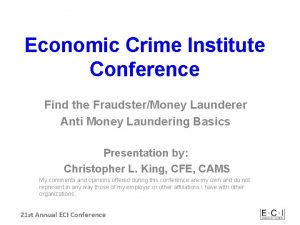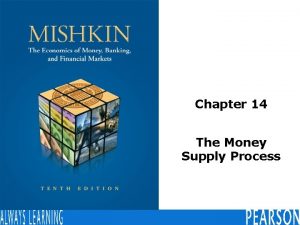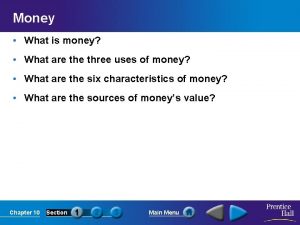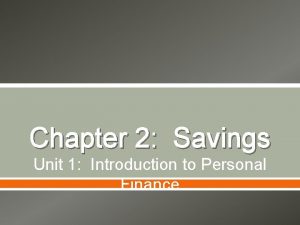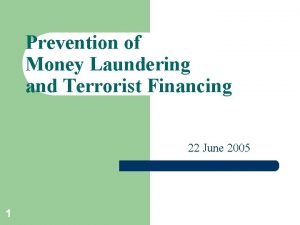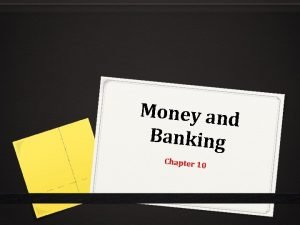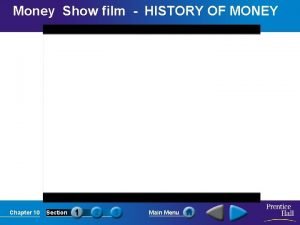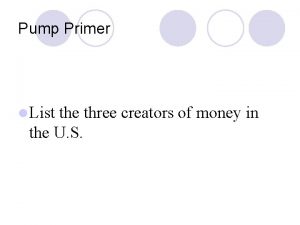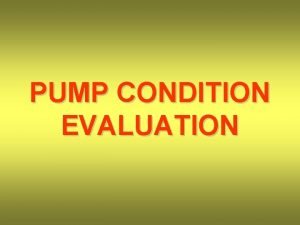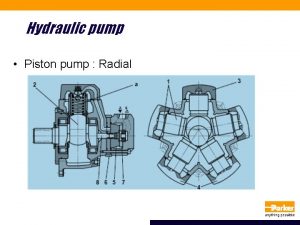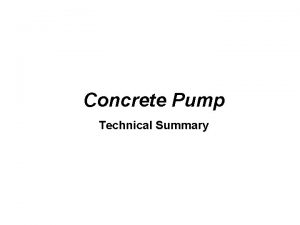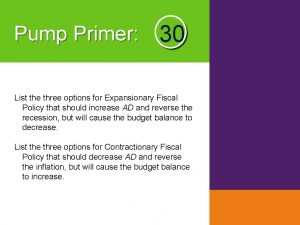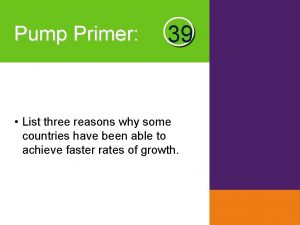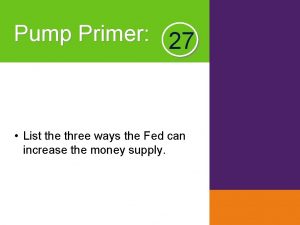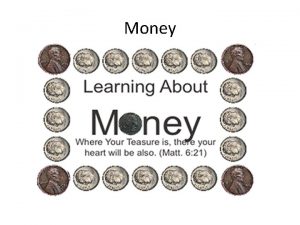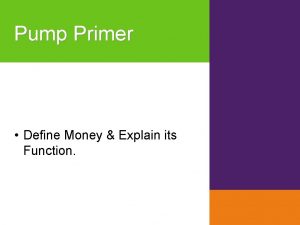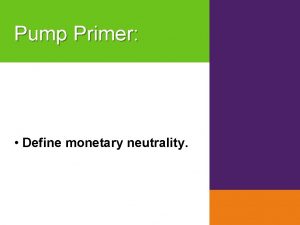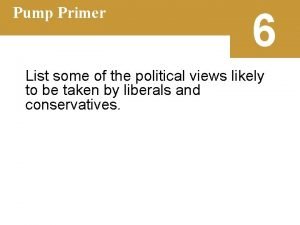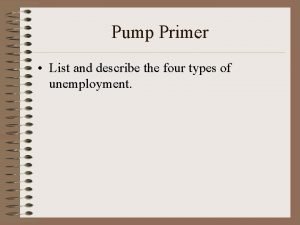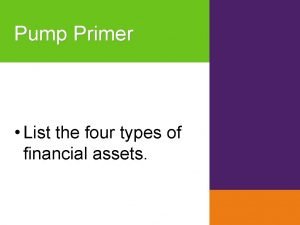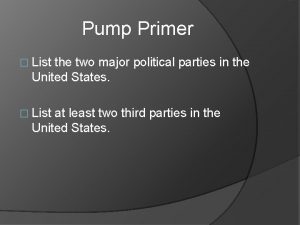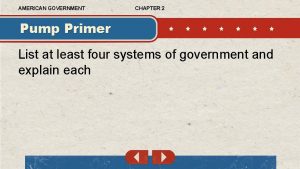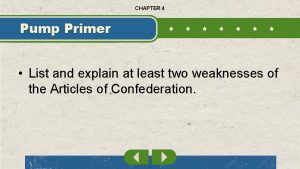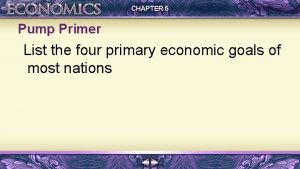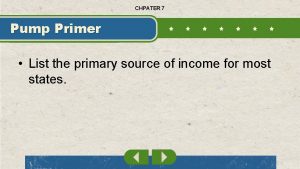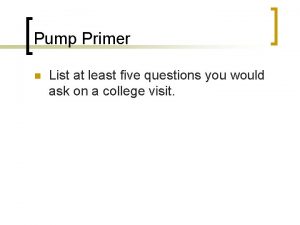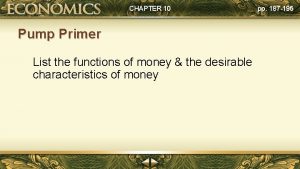Pump Primer List the three creators of money































![The Federal Open Market Committee [FOMC] • “The Fed’s chief body for monetary policymaking. The Federal Open Market Committee [FOMC] • “The Fed’s chief body for monetary policymaking.](https://slidetodoc.com/presentation_image_h2/0b0d0ef7ab786e2ca922c3c9c1ef219f/image-32.jpg)


















- Slides: 50

Pump Primer • List the three creators of money in the U. S.

“ECONOMICS for Christian Schools” By Alan J. Carper Bob Jones University Press. 1998 Unit IV: Economics of the Financial Market

“Central Banking” Chpt. 11

Objectives: • • List the three creators of money in the U. S. Explain why the Federal Reserve System was organized Describe the supervisory bodies of the Federal Reserve Explain the necessity of the Federal Reserve List and describe the functions of the Federal Reserve Describe the effects that change the discount rate Describe the effects of the open market operations has upon the money supply • Identify two reasons that the Fed attempts to control the supply of money • Explain the dangers of the Fed's actions to control the money supply

BIBLICAL INTEGRATION • Wisdom and understanding are to be more valuable than money. "How much better is it to get wisdom than gold! and to get understanding rather to be chosen than silver!“ Prov. 16: 16

Central Banking FDIC Federal Reserve System Federal Reserve Bank FOMC

Central Banking • What is a central bank? A public authority that provides banking services to banks and regulates financial institutions and markets. (“Who Is the FDIC? ”)

Central Banking • Why should you keep your money in a bank? • Safety • Convenience • Cost • Security • Financial Future (“Who Is the FDIC? ”)

Central Banking • Choosing An Account 1. Decide what type of account suits your needs the best. 1. Checking 1. Student/College 2. Interest baring 2. Savings 1. Student/College 2. Money Market (“Who Is the FDIC? ”)

Central Banking • Choosing A Bank? – Services – Fees – Convenient – Insured (FDIC) (“Who Is the FDIC? ”)

• Independent Agency – Created: 1933 – Started: January 1, 1934 – Main Office: Washington, D. C. • Preserves and Promotes Public Confidence – Insuring accounts up to $250, 000 (thru 12/31/2013; 1/1/2014 returns to $100, 000) • Banks • Thrift Institutions (“Who Is the FDIC? ”)

• Does not insure: – Securities – Mutual funds – Stocks, or any other types of investments that the bank or thrift institutions may offer. (“Who Is the FDIC? ”)

• Banks are chartered by: – States (and/or) – Federal Government • State chartered banks still have the choice of joining the Federal Reserve System. (“Who Is the FDIC? ”)

• Managed by a five member Board of Directors – Appointed by the President – Confirmed by the Senate – No more than three from the same political party (“Who Is the FDIC? ”)

FDIC Board of Directors Sheila Blair, Chairman Martin Gruenberg, Vice Chairman Thomas Curry, Director John Dugan, Comptroller of the Currency John Bowman, Director of the Office of Thrift Supervision (“Board of Director…”)

THE FEDERAL RESERVE SYSTEM • The Fed’s Policy Tools – The Fed uses three main policy tools: • Required reserve ratios • Discount rate • Open market operations (Bade 665)

Reserve Banking System • “The money loaned out by real banks does not sit in bank accounts—it gets spent almost immediately by the borrowers. • Only a small fraction of the amount deposited in banks are kept on reserve, either in electronic accounts at the Federal Reserve or in vault cash. • The result is that not everyone can get their money out of the bank in cash on the same day. ” (Hill)

Required Reserves • “The Federal Reserve requires most banks to hold a portion, up to 10 percent, of their deposits in reserve. These are called required reserves. ” • Present rates: – $0 to $10. 7 million = 0% – More than $10. 7 million to $55. 2 million = 3% – More than $55. 2 million = 10% (Hill)

Discount Rate – “The discount rate is the interest rate at which the Fed stands ready to lend to commercial banks. ” – “A change in the discount rate begins with a proposal to the FOMC by at least one of the 12 Federal Reserve banks. ” – “If the FOMC agrees that a change is required, it proposes the change to Board of Governors for its approval. ” (Bade 665)

Open Market Operations “An open market operation is the purchase or sale of government securities—U. S. Treasury bills and bonds—by the New York Fed in the open market. When the New York Fed conducts an open market operation, the New York Fed does not transact with the federal government. ” (Bade 666)

Monetary Base “The monetary base is the sum of coins, Federal Reserve bills, and banks’ reserves at the Fed. ” – “The monetary base is so called because it acts like a base that supports the nation’s money. ” – “The larger the monetary base, the greater is the quantity of money that it can support. ” (Bade 666)

How the Fed’s Policy Tools Work – By selling securities in the open market, the Fed can decrease the monetary base. – All these actions lead to an increase in the interest rate. (Bade 667)

How the Fed’s Policy Tools Work – “By decreasing the required reserve ratio, the Fed can permit the banks to hold a smaller quantity of monetary base. – By lowering the discount rate, the Fed can make it less costly for the banks to borrow. – By buying securities in the open market, the Fed can increase the monetary base. – All these action lead to a decrease in the interest rate. ” (Bade 667)

• The Structure of the Federal Reserve –The key elements in the structure of the Federal Reserve are • • The Chairman of the Board of Governors The Regional Federal Reserve Banks The Federal Open Market Committee (Bade 663)

Three Creators of Money 1. United States Treasury 2. Financial Institutions 3. Federal Reserve System (Carper 141)

U. S. Treasury: (Division of the Treasury Department) • Mints and sells coins to the Federal Reserve Banks – Creates the coins for only a fraction of their (Carter, 147) face value!

Financial Institution • Creates money by lending out customer’s deposits to others. (Carter, 147)

• Federal Reserve Bank – Under Supervision of the Board of Governors • Located in Washington, D. C. • Appointed by the president and confirmed by the Senate • Serve 14 yrs. terms (www. federalreserve. gov)

Federal Reserve System: (Fed) • • • Provides Resilient National Currency Nation’s Financial Agent Regulating Private Banking System National Check-Clearing Mechanism Banking Institution for the Nation’s Banks (Carter, 147)

Operate the nation’s payments system: • The 12 Federal Reserve Banks provide: – “banking services to depository institutions; • they maintain reserve and clearing accounts to provide various payment services, including collecting checks, electronically transferring funds, and storing, distributing, receiving, and processing currency and coin. – For the federal government: • the Reserve Banks maintain the Treasury Department’s transaction account, • pay Treasury checks, • process electronic payments, • issue, transfer, and redeem U. S. government securities. ” (Hill)

Federal Reserve Bank • Income – Interest earned on gov. securities – Priced services to depository institutions – NOT OPERATED FOR PROFIT! • End of fiscal year money is turned over to the U. S. Treasury Department. (“Federal Reserve Board”)
![The Federal Open Market Committee FOMC The Feds chief body for monetary policymaking The Federal Open Market Committee [FOMC] • “The Fed’s chief body for monetary policymaking.](https://slidetodoc.com/presentation_image_h2/0b0d0ef7ab786e2ca922c3c9c1ef219f/image-32.jpg)
The Federal Open Market Committee [FOMC] • “The Fed’s chief body for monetary policymaking. • The FOMC’s decisions ultimately affect interest rates. • The FOMC meets in Washington, usually eight times a year. ” (Emery)

“The Board of Governors meets regularly, typically every other Monday. The public is invited to attend meetings that are open under the Government in the Sunshine Act. ” (Meet twice a month pursuant to title 5, section 552 b, of the U. S. Code) (“Federal Reserve Board”)

There are 12 Federal Reserve banks, one for each of 12 Federal Reserve districts. • Each Federal Reserve Bank has nine board of directors, three of whom are appointed by the Board of Governors and six of whom are elected by the commercial banks in the Federal Reserve district. • The Federal Reserve Bank of New York implements some of the Fed’s most important policy decisions (Bade 664)

Each Federal Reserve district has its own Federal Reserve Bank. The Board of Governors of the Federal Reserve System is located in Washington, D. C. (Bade 664)

Recap! FDIC: Five member – Board of Directors Federal Reserve Bank: Seven member – Board of Governors Twelve Districts: (each) Nine member Board of Directors FOMC: Twelve member committee: – Fed Board of Governors (seven members) – President of the Federal Reserve Bank of N. Y. – Four other Federal Reserve Presidents (serving a one-year term)

Bank Failure • When many depositors run into a bank at the same time to get their money out, we call that a bank run. • When a bank run that begins at one bank spreads to other banks and causes people to generally distrust banks, we call that a bank panic. ” (Hill)

Bank Failure • “Throughout history, there have been episodes where too many people tried to take their money out of their banks at the same time. During such episodes, banks usually ran out of cash and therefore couldn’t honor withdrawal requests, and many banks went bankrupt. When a bank goes bankrupt, it’s called a bank failure. (Hill)

Great Depression • In A Monetary History of the United States, 1867 -1960 (1963), Milton Friedman and Anna Schwartz attributed much of the depression's severity to four banking crises, or panics. They argued that the crisis of late 1930 and early 1931, in particular, converted a mild recession into a major depression as "a contagion of fear" initiated by crop failures swept the country. • Friedman and Schwartz reported the significant increase in the failure rate (761 banks during November 1930 to January 1931, compared with 744 during the first ten months of 1930), led by New York City's Bank of the United States, then the largest failure in American history. ” (Friedman 308 -311)

Great Depression • They found the Federal Reserve guilty of neglect for failing to deal with these panics, a failure that was particularly culpable because correct, "lender-of-last resort, " actions would simply have required "the policies outlined by the System itself in the 1920 s, or for that matter by Bagehot in 1873" (Friedman 407)

Output • “This economic variable is a key indicator and serves as a gauge of the economy’s ability to provide products and services to people. Over the long run, the standard of living rises when this indicator grows faster than the population. One of the goals of the Federal Reserve’s monetary policy is to achieve maximum sustainable growth of this economic variable. ” (Hill)

Establish and implement monetary policy: • Using the tools of monetary policy, the Federal Reserve can affect the volume of money and credit available in the economy and the price of credit— interest rates. In this way, the Federal Reserve can influence the general level of prices, employment, and output. (Emery)

Monetary Policy • “By making credit conditions tighter or easier, monetary policy can help dampen inflationary and recessionary pressures that have historically led to economic booms and busts. Although monetary policy cannot prevent business cycles from occurring, it can help make them less severe. ” (Emery)

Changes to the Money Supply • “The Fed tracks trends in many areas of economic activity using economic indicators to see if there are signals pointing to recession or inflation, or whether the risks of recession and inflation are balanced. ” (Emery)

Over-stimulating the Market • “Lowering the federal funds rate will likely cause other short-term interest rates to fall and will help stimulate investment and the economy in the short run. This effect would be helpful if the economy were slowing but would be harmful if it caused inflationary pressures to build. ” (Emery)

Over-tightening • “Raising the federal funds rate will slow investment in the economy in the short run. Raising the federal funds rate would be appropriate if the economy showed signs of overheating and inflationary pressures were building. • However, if the economy were already slowing, a higher federal funds rate would tend to weaken it. ” (Emery)

Inflation • “This condition occurs when there is an increase in the average level of prices of the products and services we buy. • Significant changes in the price level distort economic incentives because those changes alter the purchasing power of money. • A 5 percent annual rate of increase in prices means that the income you earn this year will buy 5 percent less next year. • One of the goals of the Federal Reserve’s monetary policy is to achieve price stability—that is, no overall tendency for the prices of goods and services to generally rise or fall. ” (Hill)

Effects of Interest Rates • “Higher interest rates mean that credit is more expensive. When credit is more expensive, businesses are less likely to invest in additional capital needed to expand output and consumers are less likely to purchase homes and large items that require them to borrow. • When interest rates are low, credit is less expensive and businesses are more likely to invest in additional capital and expand output. Likewise, consumers are more likely to buy homes and other large items. ” (Hill)

FOMC • Committee of Twelve: – Fed Board of Governors (seven members) – President of the Federal Reserve Bank of N. Y. – Four other Federal Reserve Presidents (serving a one-year term) “Regardless of their voting status, all Reserve Bank presidents contribute to the FOMC’s discussions and deliberations. ” (“Federal Reserve Board”)

Works Cited “Board of Directors & Senior Executives” FDIC. gov 3 Jan 2006. 14 Mar 2006 Blade, Robin, and Michael Parkin. Foundations of Economics: Instructor’s Manual. 2 nd ed. Boston: Pearson Education, Inc. , 2007. Carper, Alan. Economics for Christian Schools. Greenville: Bob Jones Uniersity Press, 1998. Emery, Barbara. “Monetary Policy”. Federal Reserve Bank of Philadelphia. 18 Feb 2009<http: //www. philadelphiafed. org/education/teachers/lessonplans/index. cfm? tab=3&CFID=1604898&CFTOKEN=97766325&jsessi onid=383079 bdcb 242 df 693 e 17 a 7 e 4 b 313 a 554 b 54> “Federal Reserve Board”. Federalreserve. gov. 1 March 2006. 14 March 2006. <http: //www. federalreserve. gov/general. htm > Friedman, Milton and Anna Schwartz. A Monetary History of the United States, 1867 -1960. Princeton University Press; 1963. Hill, Andrew T. “What Does the Fred Do? Federal Reserve Bank of Philadelphia. 18 Feb 2009. <http: //www. philadelphiafed. org/education/teachers/lessonplans/index. cfm? tab=3&CFID=1604898&CFTOKEN=97766325&jsessi onid=383079 bdcb 242 df 693 e 17 a 7 e 4 b 313 a 554 b 54> “Who is the FDIC? ”. FDIC. gov. 28 Jul 2003. 11 March 2005. <http: //www. fdic. gov/about/learn/symbol/index. html>
 Who are the three creators of money in the united states
Who are the three creators of money in the united states Money money money team
Money money money team Language windows 10
Language windows 10 Uml creators
Uml creators Creators spend as much time as possible in quadrant
Creators spend as much time as possible in quadrant John was busy yesterday evening
John was busy yesterday evening Slip in reciprocating pump
Slip in reciprocating pump Internal vs external gear pump
Internal vs external gear pump Screw pump vs gear pump
Screw pump vs gear pump Symbolism in great gatsby
Symbolism in great gatsby Money smart money match
Money smart money match Money on money multiple
Money on money multiple Satire in the great gatsby
Satire in the great gatsby Context of the great gatsby
Context of the great gatsby Primer name list
Primer name list Primer names
Primer names Recni tovarni list
Recni tovarni list She wanted three things money power and security
She wanted three things money power and security What three functions does money serve
What three functions does money serve What are the 3 stages of anti money laundering
What are the 3 stages of anti money laundering The three players in the money supply process
The three players in the money supply process What are the three uses of money
What are the three uses of money Unit 1 chapter 2 saving answers
Unit 1 chapter 2 saving answers Money laundering stages
Money laundering stages What are the three uses of money
What are the three uses of money The three uses of money
The three uses of money Actual reserves formula
Actual reserves formula Hình ảnh bộ gõ cơ thể búng tay
Hình ảnh bộ gõ cơ thể búng tay Bổ thể
Bổ thể Tỉ lệ cơ thể trẻ em
Tỉ lệ cơ thể trẻ em Chó sói
Chó sói Tư thế worm breton
Tư thế worm breton Alleluia hat len nguoi oi
Alleluia hat len nguoi oi Các môn thể thao bắt đầu bằng tiếng nhảy
Các môn thể thao bắt đầu bằng tiếng nhảy Thế nào là hệ số cao nhất
Thế nào là hệ số cao nhất Các châu lục và đại dương trên thế giới
Các châu lục và đại dương trên thế giới Công thức tiính động năng
Công thức tiính động năng Trời xanh đây là của chúng ta thể thơ
Trời xanh đây là của chúng ta thể thơ Mật thư anh em như thể tay chân
Mật thư anh em như thể tay chân 101012 bằng
101012 bằng Phản ứng thế ankan
Phản ứng thế ankan Các châu lục và đại dương trên thế giới
Các châu lục và đại dương trên thế giới Thơ thất ngôn tứ tuyệt đường luật
Thơ thất ngôn tứ tuyệt đường luật Quá trình desamine hóa có thể tạo ra
Quá trình desamine hóa có thể tạo ra Một số thể thơ truyền thống
Một số thể thơ truyền thống Cái miệng xinh xinh thế chỉ nói điều hay thôi
Cái miệng xinh xinh thế chỉ nói điều hay thôi Vẽ hình chiếu vuông góc của vật thể sau
Vẽ hình chiếu vuông góc của vật thể sau Nguyên nhân của sự mỏi cơ sinh 8
Nguyên nhân của sự mỏi cơ sinh 8 đặc điểm cơ thể của người tối cổ
đặc điểm cơ thể của người tối cổ Thế nào là giọng cùng tên
Thế nào là giọng cùng tên
